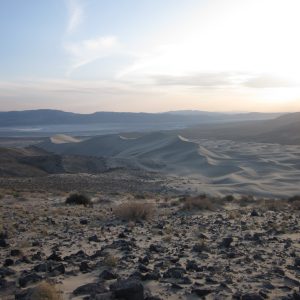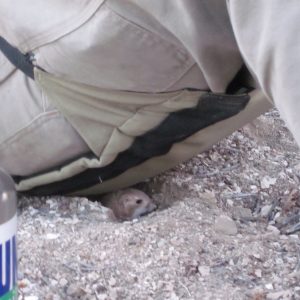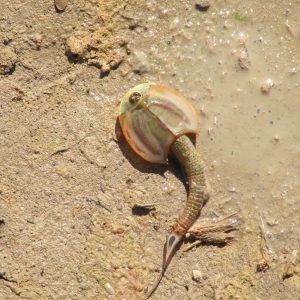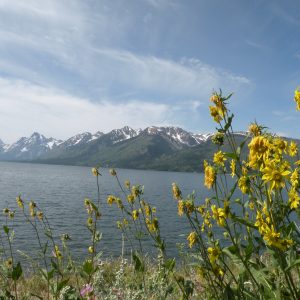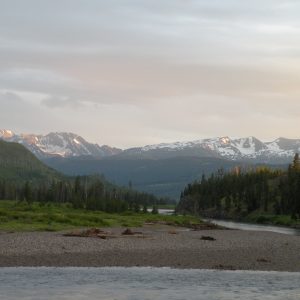SOS! – No, not the call for help… Seeds of Success!
Is it August already? Time is flying by before my eyes in that almost two months have already whizzed by out of my five month internship in Denver, Colorado and I feel like I’ve still only just begun. Our tasks have now altered from performing monitoring or seed collecting in blocks of a week, to being more intermixed together throughout a week. This variety doesn’t help slow down time, but makes this job very enjoyable and fun.
After seed scouting six sites for six days over a four week period (the two middle weeks vacant of Seeds of Success), we finally found a site with enough individuals and sufficient amount of fruits with plenty of seeds to reach at least our 10,000 seed quota from only 20% of the population and waited just the right amount of time for the fruits to ripen for healthy seeds, but not too late that they would all be dispersed and gone. Our first collection of this season was from Scutellaria brittonii, a skullcap group within the mint family, which was not an easy task, especially for mine and Sama’s first seed collection extravaganza!
This mint is only about 3 to 6 inches tall, grows in small scattered clumps on talus slopes of mountain sides in open pockets, and without their little lavender skull-looking flowers, they are very easy to miss. We did a lot of scrambling across steep slopes looking and harvesting Britton’s Skullcap fruits just off the path, or sometimes a ways down or up from the path. Another issue was that not all the fruits ripen at the same time. So, because of their spread-out distribution and many of the fruits not being ripe, it took us more than one day to collect an ample amount of seed for this program. Our first day, many of the fruits were not ripe enough, and a small fraction of the seeds were ready to be collected. Our second trip was quite the opposite with most of the fruits already gone and their tiny brown seeds dispersed. Our third try was to top off our collection to guarantee that we collected enough.
Besides collecting seeds, we also have to collect data about the plant and the site we are collecting from. This includes the date(s) of this species’ collection, the eco-region, location, land formation, habitat, associated plants, estimated area of the collection, the population, and the number of plants sampled, average number of fruits per individual, and average seeds per fruit, slope, aspect, soil texture, soil color (from a chart), etc. After the collection is made and the data collected, the data is typed and printed onto a form and packaged with the seeds, and then shipped off to Bends, Oregon to be cleaned, analyzed, and determined if there are enough viable seeds for research and storage.
Thankfully, our second collection was on Clematis hirsutissima, a buttercup species that only took one day to collect, then shipped off the next day. Our third is currently in progress, collecting fleshy fruits of Rhus trilobata, Skunkbush Sumac, that will take at least one to two more trips to get more than 10,000 seeds. Each bush, when fruiting, has between 50 to 1,000 fruits, but each fruit only has one seed, which is why it will take us a while. Our first attempt barely gave us 5,000 seeds, but not all are viable and ripe, so we are planning on two more trips to guarantee our “Success” since not every year is so bountiful with this shrub. This fruit is also fun to collect because the fruits are very sticky, so we wear latex gloves to keep our hands clean, but also because it is in the same family as poison ivy and has been known to cause skin irritation for some people.
This is Jeffrey Flory from the Colorado State Office, signing off of the CLM blog.
Botanizing in the Alaska Arctic
I still am in awe of where I am, and how my summer has come to be with my internship. I find myself in vast meadows of lupine, and then crouching beside a chocolate lily, or climbing rocky mountainsides in search of Crepis elegans (elegant hawksbeard–gotta love the name), wading on edges of alpine lakes identifying Carex species, and then identifying the entire plant community of a black spruce forest.
And most recently I found myself out in the far reaches of Alaska’s North Slope! I had the incredible opportunity of being a research assistant for two weeks on a project in the BLM’s National Petroleum Reserve-Alaska (NPR-A) monitoring the effects of oil exploration on the tundra. Such a beautiful and strange world up there! The Coastal Plain (aka North Slope) consists of hundreds of lakes and intricately meandering streams across a completely flat landscape, about 1/3 water from melting permafrost and 2/3 land.
On the North Slope, I lived in the remote BLM field camp of Inigok, 30 miles south of the Beaufort Sea of the Arctic Ocean. The camp was accessible by air only and lay 100s of miles from any other major “civilization.” Our camp consisted of canvas cook tent, pantry tent, and a “lounge” with wireless. My camp-mates were a crew of 12 or so biologists and other researchers from all over the country doing projects on fish, botany, caribou, and climate change in the arctic.
For our research, we flew around in a helicopter collecting a variety of data from 88 sites across the tundra. The project was in its 13th year monitoring the effects of seismic exploration for oil and ice roads on tundra flora. We looked at impact to tussocks (Eriophorum vaginatum), riparian areas, and other tundra communities. We visually noted rate of plant recovery from ground and air, trying to see how long recovery is for flora after being driven over in multiple ton vehicles in the winter. Depending on what substrate or ecosystem was effected, full plant recovery has been anywhere from 2 years to still not recovered today. Such a beautiful, fragile ecosystem up there, I feel lucky to have participated in the quest for understanding Arctic ecosystems!

My work team: our helicopter pilot on the left, then botanist/wildlife biologist Dave, and me on the right
Such an adventure! I’ve learned so much up here. I can name all the tundra plants by common name and Latin. I ate a puff ball mushroom fresh off the tundra, saw a few grizzly bears running from our helicopter and saw a rare herd of musk ox. I got to see a herd of five thousand caribou swimming across a lake, and touched the permafrost–the hard and frozen ice under all this land. And I learned to play cribbage!
A Giant, Isolated Sand Dune In Nevada
I feel privileged to have been able to work at so many great locations for this internship. One of my favorites is Sand Mountain, a 600-foot high, 2 mile long sand dune in west-central Nevada that is a glaring anomaly in what is otherwise typical basin and range landscape. ATVs are the most time-effective way to travel around in dunes, and we have used them in our efforts to plant buckwheat for a rare butterfly, survey for rare plants, and collect native seed. Wildlife we have seen includes horny toads, which partially bury themselves in the sand to avoid being seen, scorpions that glow under a black light, and a kangaroo rat that was so curious and habituated that it came into our camp and dug a little burrow directly under a co-intern’s rear end. This same critter later ran up another intern’s pant leg later on, followed by a stay under my legs.
We camped on the east side of the dune area during our most recent visit, and in the adjacent valley, the military does electronic warfare, which is a type of training, so we would see flashes of light and flame in the distance, adding another odd dimension to an already unusual area.
Next week, we will be heading to a completely different landscape, that of the tufa towers of Mono Lake. In addition to collecting seed near the lake, we will be visiting Bodie State Historical Park to gain new perspectives on resource management issues, and we will be helping with botanical education at a youth camp. I’m really looking forward to it!
Carson City, NV
Well I’ve been here for approximately 4 months now, and I’m really starting to love the West. This internship is giving me a good feel for the native plants out here, as well as the non-native. The past few weeks we have been doing a lot of seed collection for the Seeds of Success program. This is sometimes harder than it seems, because you need to be in the right place at the right time to collect the seeds. Also, I have been herbiciding the invasive whitetop, Lepidium draba, for the past few weeks. Whitetop is definitely a problem species out here because of its ease of growing in poor conditions as well as speed of growth. We initially went in to cut down the white top to the roots, which hurts the plants. After a few weeks we go back and spray with the herbicide to hit it again, in hopes of eradication. The next few weeks we will be doing some intense fire-rehab monitoring so I hope to learn a lot in this time.
Amber Kowal
Surveying for (and finding!) blowout penstemon
Two additional populations of blowout penstemon were found in central Wyoming, by a few hardworking and dedicated CBG interns. Yep, I happen to be one of those interns.
For me, it all started on a cold, wet July morning in Rawlins, WY. I was to meet two other people at the old “town” of Ferris. Down a winding two-track road I drove, with some bluegrass on the radio and the Ferris Mountains guiding my way. I finally met up with my group after a few miles and got out of the government rig to talk about our strategy for surveying the surrounding sand dunes for occupied blowout penstemon habitat. After some discussion it was decided that I would trek around with Emma, a CBG intern based out of Laramie, WY. Emma has spent much time looking at aerial photos of Aeolian (wind-derived) sand deposits in the state, with the goal of mapping all potential habitat for blowout penstemon in the state.
After stuffing some rain gear, food and water into our packs, Emma and I headed towards the sand dunes that are scattered across the valley south of the Ferris Mountains. With the storm clouds building above us we made a pact to head back to the trucks if the rain became a nuisance. I had been out with Emma before scouting for blowout penstemon and had no luck, so I was unprepared to almost step directly on a plant less than 1 mile from where I left my truck. It was at this time that rain drops began to fall. After a high-five, we got out our pencils and paper, threw on our rain gear, and started to systematically survey the sand dune. Within 10 minutes we were soaked, and had only found a few additional plants. We discussed our pact about quitting once the rain became a nuisance, which it had become, but decided to keep on scouting for additional plants. After a few hours, we were smeared with sand, our fingers were turning blue, BUT we had found over 80 blowout penstemon plants that have never been documented before in the area. As we made our way back, the clouds began to break and by the time we arrived back to our trucks the sun was fully out. We ate a late lunch, with our bare feet basking in the sun and our boots and socks strewn across the hood of the trucks to dry out. It was a good day.
Beyond surveying, still working on updating the statewide programmatic biological assessment for blowout penstemon in WY and preparing for a meeting with the USFWS next week….
Alaska, The Last Frontier
Getting the opportunity to work with the BLM in Alaska is quite literally something I never imagined doing. Alaska has always seemed like a foreign country, especially growing up on the east coast. I’ve been here for almost a month now and I can honestly say I don’t think I’ll ever get used to the breathtaking views.
 Five days after I arrived we embarked on our first journey to Chicken, AK to scout areas to return to when the seeds become ready to collect. Now I know, it’s pretty crazy just coming to Alaska, then immediately I get to go on this week long road trip to this exotic seeming place called Chicken. The trip up there was amazing, driving through so many different eco-regions was a great way to start learning about Alaska’s environment first hand.
Five days after I arrived we embarked on our first journey to Chicken, AK to scout areas to return to when the seeds become ready to collect. Now I know, it’s pretty crazy just coming to Alaska, then immediately I get to go on this week long road trip to this exotic seeming place called Chicken. The trip up there was amazing, driving through so many different eco-regions was a great way to start learning about Alaska’s environment first hand.
Although I am up here learning about so many cool plants, I have to admit the highlight of my trip so far is the wildlife we’ve gotten to see. On the way up we saw some muskrats in a small pond, a red fox at the edge of the road, some moose, a Peregrine Falcon haunting hikers along a trail, and a bear swim across a river (there are still arguments whether it was a small grizzly or a black bear). The most exciting of all, we saw a Lynx!! It was so beautiful and graceful with its large paws that can be called “built-in snow shoes.” This was such an amazing experience considering very few people who have been in Alaska for years have seen a Lynx, and I’ve seen one after being here for only a week. Now we are getting to the heart of the collecting season and I can’t wait to travel all over the state and have so many more great experiences, and collect seeds of course!
Cody, WY- Part 3
Well, the fuzzy little eaglets I’ve been watching since May have now grown up to full-sized juveniles and flown the coop. It’s sad to see them go, but I wish them luck. It’s strange to suddenly have time to do other things now, but staying busy is no difficult task. I’ve finally begun collecting hawksbeard and dune scurfpea for the Seeds of Success program, which takes longer than I had expected it would by myself, and at last have been getting out into new portions of the field office searching for reservoirs in which to document reptile and amphibian species. Primarily I’ve been looking for tiger salamanders and spadefoot toads, but have also found chorus frogs and a species of garter snake that seems to like swimming. I’ve also found triops, which is a crustacean whose form has apparently remained unchanged for millions of years and is considered a living fossil. I never would have expected to find a creature that looks like a little horseshoe crab way out here in a vernal pool in Wyoming, yet here it is! Wyoming is full of surprises.
One definite geographic benefit of working here is being in such close proximity to amazing places like Yellowstone, Grand Teton National Park, the Shoshone National Forest, and other relatively protected areas. It’s so nice to be able to get out of town and spend a weekend camping or hiking and just seeing new places. And who knows– all that hiking and camping could become an asset in applying for future jobs that may require backcountry experience. It’s also just an opportunity to do things I couldn’t do at home in Nebraska, where there aren’t any mountains to hike in or ski on, and camping in bear country is certainly an eye opener! I’m afraid I’m getting spoiled here. Home amongst the cows and cornfields and small cities is still home, and I’m sure I will enjoy plenty of my future jobs, but life as an intern in Cody is pretty darn good. I hope the last few months will go by slowly so I can take it all in.
- Either a metamorph or paedamorph tiger salamander
- One of the little garter snakes that likes to swim
- A triops, a living fossil
- Sunflowers with a view of the Tetons
- Sunset view from my weekend campsite
Nevada weeks 9-10
Hello,
Well, another two weeks have come and gone, the last being by far the dirtiest! We spent the last week camped at the Hoyt Fire area about a three hour drive east of Carson City doing post fire monitoring. Even though it has been several years since it last burned the predominant dust is soot, therefore, rather than becoming dirt colored by the end of the day, you become soot colored. Even though we all wear long pants and I wear long sleeves it doesn’t seem to matter. Any skin, exposed or not- turns black. Any how, just another day at the office right?
We ended up having a good week any way. In the bustle of packing the Tahoe on Tuesday morning to head out we forgot to throw one of the tents in so the first night Sasha opted for sleeping under the stars and Andie and I shared the tent. That worked fine but the next night Sasha found that a scorpion had taken up residence under her sleeping bag so she slept in the tent and I staked out in the Tahoe. it’s about five inches too short for me to stretch out but it worked. Thursday night there was a rattle snake departing the camp site when we came back so I was more than happy to have the truck again. So far so good on the animal contacts.
The first day out in the field we had a mama antelope and her baby do just about a complete circle around our plot, stopping to check us out several times as if the mama was saying “ok, get a good look, those are botanists!”
The animal sighting that to me takes first place merits a little explanation first. On the opposite side of RT 50 the Navy has a training facility were they do test runs and I guess you could say “target practice” so there was a pretty regular flight pattern over head as the jets went to and from the site. Of course jets fly faster than their sound so when you hear one you look up and see nothing then have to look around for them. Well, this one time they came over super low so the engine was roaring right over head- you look up real quite thinking “oh crap” and see two doves flying in perfect battle formation! After the initial suprise it was quite funny!
We hiked some pretty rugged terrain trying to get into the burn area more and away from the road so we saw some pretty picturesque areas. The skeletal trees add a rather mournful feel, but it is still cool. One day we saw about ten mule dear bucks all still in velvet but I didn’t get my camera out fast enough. Oh well.
It is getting hotter here but humidity is still absent. I am glad we don’t have a thermometer out in the field because that would just make it harder to deal with. As is you just sweat and think “gosh is it HOT!”.
This week we will be out in the same area finishing up at Hoyt and heading on to the Clan Alpine burn area just a little ways back toward Falon. Not much but a little. That burn is up on the side/top of the Clan Alpines so we will get in some good hiking those days. Hopefully we can finish up out there this week and move back to the Pine Nuts to do more Sage Grouse sites.
Guess that’s all for now.
Yuma, AZ: The Sunniest City in America (and the hottest).
Yuma is the hottest city in the US, and for the last few months daily temperatures have averaged at 105 degrees. And somehow the locals say it has been a comparatively cool summer. Despite the heat, my experience in Yuma has been and continues to be amazing.
It has been about 8 months since my arrival in Yuma and I have been working on various wildlife biology projects. Participating in the endangered marshbird survey efforts has been my favorite project so far. Boating down the Colorado River at dawn conducting endangered bird surveys was an unbelievable experience and felt nothing at all like work.
As the field season rolls on I continue to enjoy my work & free time in Yuma, despite the heat.













